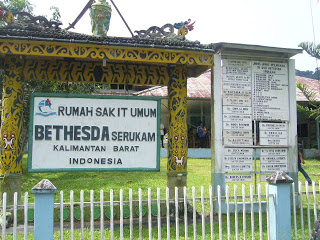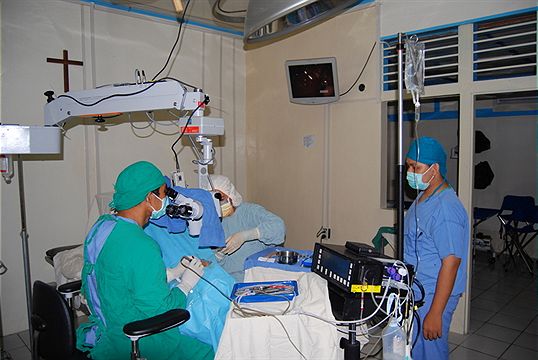Medical Ministry International in Indonesia
Project Directors, Ed & Femmy Dethan
Over the past decade, Medical Ministry International held ophthalmology projects in Indonesia.
In September 2020, we had planned our first primary care and integrated health project in the country, led by Ed and Femmy Dethan of New Hope Foundation but that was postponed due to the COVID pandemic. The project is now scheduled for November 2023.
Medical Ministry International is partnering with Global Eye Mission and Dr. Steve Anderson at the Bethesda Mission Hospital to develop a new long-term clinical and surgical eye unit to serve the people of this region.
Medical Ministry International’s support is helping to fund the educational and training costs of Dr. Vika, an Indonesian ophthalmologist. Dr. Vika is in her ophthalmology residency training and plans to take over the long-term leadership of the eye unit at Bethesda Mission Hospital. We have also trained an ophthalmologist from Indonesia, Dr Eva Dewi, who is now serving in Bolivia.
Bethesda Mission Hospital, located on the island of Borneo, has served the people of rural West Kalimantan, Indonesia for over 40 years. The hospital has grown over the years to become a resource for the region serving the economically poor and is sought out for its reputation of quality care and compassion. Many people in Borneo suffer from various vision impairments that can be addressed with glasses, medical treatment, or surgery. There is a great need for eye care in this underserved region with a ratio of ophthalmologists to population of about 1:1,000,000.
Project Site:
Kupang is the capital of the Indonesian province of East Nusa Tenggara, and has an estimated population in 2011 of 349,344. It is the biggest city and port on the island of Timor, with the formal sector of the manufacturing sector mainly basing on the cement industry. Kupang is a multi-ethnic city of the tribe of Timor, Rote, Sabu, Flores, a small ethnic Chinese and immigrants from Ambon and several other tribes.
* Project Description: The projects in Kupang are are intended to provide Primary Care, Dental Care, and Health Education to the those with no or limited access to those services in the area.
Elevation
62 m (203 ft)
Climate
Kupang has a tropical wet and dry climate. October is the hottest month (average temperature 28.8 °C/83.8 °F) and July the coolest (average temperature 26.1 °C /79.0 °F). January is the wettest month, while August and September are the driest.
Travelling on a Project
About Indonesia
COUNTRY BACKGROUND
Indonesia, a nation between the Indian and Pacific oceans, is made up of thousands of volcanic islands and is home to hundreds of ethnic groups speaking over 700 different languages. It is the world's largest island country, with more than 17,000 islands. It’s known for beaches, volcanoes, Komodo dragons and jungles sheltering elephants, orangutans and tigers. With over 261 million people, it is the world's 4th most populous country.
In recent decades, health indicators have significantly improved such as rising life expectancy (from 63 in 1990 to 71 in 2012) and declining child mortality (from 84 deaths per 1,000 births in 1990 to 27 deaths in 2015). Nevertheless, Indonesia continues to face health challenges that include maternal and child health, low air quality, malnutrition, high rate of smoking, and communicable diseases.
LOCATION:
Indonesia is a country in Southest Asia located near Malaysia and Papua New Guinea.
GEOGRAPHIC COORDINATES:
0.7893° S, 113.9213° E
MAP REFERENCES:
Southeast Asia
CLIMATE:
Split by the equator, Indonesia has an almost entirely tropical climate, with the coastal plains averaging 28°C, the inland and mountain areas averaging 26°C, and the higher mountain regions, 23°C. The area's relative humidity is quite high, and ranges between 70 and 90 percent.
TOTAL AREA:
1.905 million km²
BORDER COUNTRIES:
Indonesia shares land borders with Malaysia on Borneo, Papua New Guinea on the island of New Guinea, and East Timor on the island of Timor. Indonesia shares maritime borders across narrow straits with Singapore, Malaysia, Vietnam, the Philippines, and Palau to the north, and Australia to the south.
COASTLINE:
54,720 km (34,000 mi)
TERRAIN:
Mostly coastal lowlands; larger islands have interior mountains.
ELEVATION EXTREMES
LOWEST POINT:
Ayu Trough, Western Pacific Ocean: −5,600m (−18,400 ft)
HIGHEST POINT:
Puncak Jaya, Sudirman Range, Mimika Regency, Papua: 4,884 m (16,024 ft)





